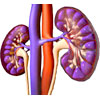When a kidney transplant fails, home-based dialysis is an option
Patients returning to dialysis after kidney transplant failure present unique challenges compared with other dialysis patients: they have been exposed to very powerful immunosuppressive medications and have been on dialysis for a longer period of time than other dialysis patients. This puts them at particularly high risk for various complications and death. According to a study appearing in an upcoming issue of the Clinical Journal of the American Society of Nephrology (CJASN), despite complications, these patients can choose to undergo dialysis in the comfort of their own homes.
Patients who have had a kidney transplant are used to managing their own therapy, enjoying the ability to travel, and living a relatively flexible lifestyle and may therefore be well-suited to peritoneal dialysis (home-based) rather than haemodialysis (clinic-based), when they return to dialysis after transplant failure.
Despite the many potential benefits of peritoneal dialysis over hemodialysis – including ease of performing the therapy at home, avoidance of hospital visits several times a week, and more flexibility to travel – only a very small proportion of patients returning to dialysis after transplant failure end up choosing to undergo peritoneal dialysis in both Canada and the United States.
Jeffrey Perl, MD (St. Michael’s Hospital, University of Toronto, Canada) and his colleagues evaluated the impact that dialysis type (peritoneal vs. haemodialysis) has on the survival of patients returning to dialysis after transplant failure. The investigators studied 2,110 adult Canadian patients who initiated dialysis after their kidney transplant failed between January 1991 and December 2005. The researchers evaluated the impact of initial dialysis type on early (2-year), late (after 2 years), and overall deaths.
Haemodialysis and peritoneal dialysis patients died at similar rates in all analyses (early, late, and overall).
“It is important to empower patients who have kidney transplant failure to realise that despite the severe disappointment of returning to dialysis, they still have many options for dialysis therapy, which include opportunities for home-based therapies,” said Dr Perl.
“I hope this research helps guide patients and the healthcare professionals treating them to make informed decisions regarding dialysis modality decisions, namely that peritoneal dialysis is as effective a therapy as haemodialysis in patients returning to dialysis after kidney transplant failure.”
(Source: American Society of Nephrology: Clinical Journal of the American Society of Nephrology)
More information
 | For more information, see Kidney Transplant and Dialysis. |
Dates
Tags
Created by:

 Login
Login














